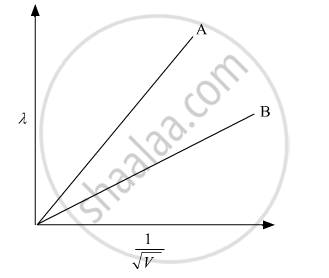Advertisements
Advertisements
प्रश्न
Plot a graph showing variation of de Broglie wavelength λ versus `1/sqrtV` , where V is accelerating potential for two particles A and B, carrying the same charge but different masses m1, m2 (m1 > m2). Which one of the two represents a particle of smaller mass and why?
उत्तर
Given: Charge (q) is the same but masses of both the particles are different (m1 > m2).
The de Brogile wavelength given by
`lambda = h/sqrt(2mqV)`
The slope of the graph λ versus `1/sqrtV `is `h/sqrt(2mq)`

The slope of the smaller mass is larger; therefore, plot A in the above graph is for mass m2
संबंधित प्रश्न
A proton and a deuteron are accelerated through the same accelerating potential. Which one of the two has the greater value of de-Broglie wavelength associated with it, and Give reasons to justify your answer.
An α-particle and a proton are accelerated through the same potential difference. Find the ratio of their de Broglie wavelength.
A deuteron and an alpha particle are accelerated with the same accelerating potential greater value of de-Broglie wavelength, associated it ?
A proton and an electron have same kinetic. Which one has greater de-Broglie wavelength and why?
A proton and an electron have same velocity. Which one has greater de-Broglie wavelength and why?
The kinetic energy of electron in (electron volt) moving with the velocity of 4 × 106 m/s will be
Find the de-Broglie Wavelength for an electron moving at the speed of 5.0 × 106 m/s. (mass of electron is 9.1 × 10-31)
A strong argument for the particle mature of cathode ray is to
The work function of a metal is 4.50 eV. Find the frequency of light to be used to eject electrons from the metal surface with a maximum kinetic energy of 6.06 × 10−19 J.
What is meant by “Dual nature of matter”?
